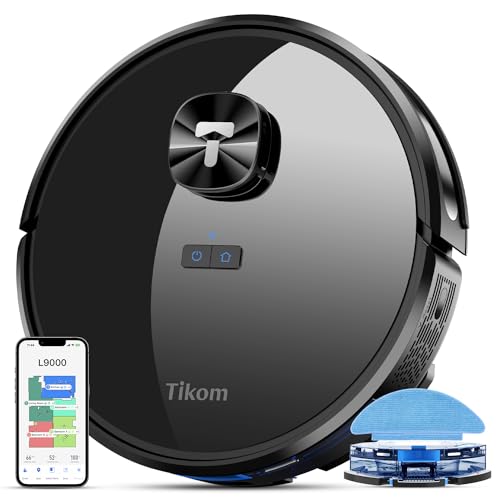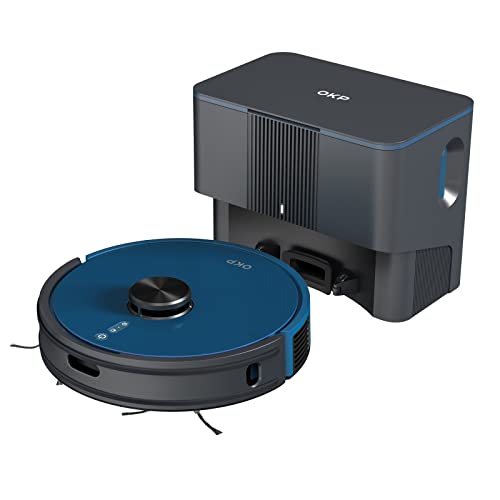Many robot vacuums aren’t able to navigate around obstacles. This can be frustrating, especially in the event of a poopocalypse.
A robot vacuum equipped with LiDAR navigation and gyroscopes does better in creating a clear map and navigating around obstacles. They tend to be more expensive than other models.
LiDAR
A robot vacuum that uses lidar can create detailed maps of your home. This allows it to move more efficiently around furniture and other objects, as well as avoid obstacles in its path. Lidar is one of the main features of premium robotic vacuums, which tend to be more expensive than their low-cost counterparts.
cheapest lidar robot vacuum (https://barrett-hall.thoughtlanes.net/get-to-know-you-the-steve-jobs-of-the-robot-vacuum-with-lidar-and-camera-industry/) is simply a spinning light. The sensor measures the amount of time taken for laser beams to reflect back on itself. It does this thousands of times per second. It then determines the exact distance of the robot from any nearby object to a centimeter.
The sensor works together with other sensors, such as cameras and gyroscopes, to create a full picture of the environment. Cameras provide information in the form of images, while the laser scanner collects data regarding the shape and position of objects. Gyroscopes assist in determining the direction of the robot as well as its orientation.
Many robots also come with drop detectors. These are activated when a robot is approaching a steep threshold or other barrier that it is unable to cross without getting stuck or causing damage. Some have wall sensors to prevent them from pinging off walls or large pieces of furniture and generating a lot noise, and even causing damage to them.
Another benefit of a robot with lidar is the capacity to adapt its course in response to changes in environment. This could be due to an item of furniture is brought into the room, or due to regular changes like children moving their toys around the house. High-end models that have lidar sensors can analyze these changes in real-time, unlike budget robots which use bump sensors. They can then adjust their speed and route according to the change.
Some of the best robot vacuum lidar robots equipped with lidar can detect changes in flooring, for instance when a robot is moving from carpet to hard flooring. These are all useful characteristics that make robots with lidar more efficient than lower-cost counterparts that use bump sensors to avoid obstacles.
Gyroscope
The majority of robot vacuums are fitted with sensors that aid them in their navigate. Whether they’re using 3D structured light or laser navigation, monocular or binocular vision based obstacle avoidance, or just a simple gyroscope, these sensors help the robot to build maps of your home and avoid obstacles that are blocking the path for cleaning. This kind of advanced obstacle detection can aid your robot in avoiding cords, area carpets, shoes, or furniture legs.
Sensors like gyroscopes are used to measure the speed of rotation of the robot wheels. They can also be used to determine the relative location of a device within aircraft, ships and cell phones. These sensors work in conjunction with other sensors, such as cameras and LiDAR to help the robot map out the space and navigate efficiently.
The navigation system of your robot can vary widely depending on the technology employed and the price. Certain models, like the Dreame F9, feature a combination of camera and lidar vacuum mop to create a complete map of your home and avoid obstacles that could be in its path. LiDAR navigation is faster and more accurate than other sensor systems and lets you create virtual boundaries for your robot, as well as set no-go zones in your home.
Camera-based navigation is slower and requires the use of a light source which could cause privacy concerns for certain users. These systems are also more susceptible to interference from reflective surfaces and complex room layouts.
Fortunately, robot vacuums come with numerous sensors that can make up for these limitations. Drop detectors are also present in the majority of robot vacuums to stop the robot from falling off a stairwell or any other significant difference between levels. This is crucial for homes with multiple levels, or for people with children or pets that might be injured by falling from a high-offset or open windows. It is recommended to select models that have multiple sensor technologies rather than using only one kind of navigation system.
SLAM
A robot vacuum that employs SLAM navigation can create an accurate map. This allows the device navigate more efficiently, avoid scratching walls or furniture, and also detect and avoid obstacles. The majority of models that utilize SLAM navigation also come with an app where users can set the boundaries of “no-go” zones for the robot to adhere to.
In contrast to bump sensors, which warn the robot when it encounters an obstacle, SLAM provides an accurate view of the space by combining information from various sources. Utilizing cameras to determine the shape and location of objects, gyroscopes that allow movement tracking and lidars for distance measurement, the SLAM system allows the robot to continuously update its maps of the environment and understand what is in its path.
This technology is often paired with other sensors like gyroscopes that track the speed of rotation, and light sensors that determine the number of times the robot’s wheel turns. Gyroscopes can be a fantastic addition to robots, as they are more efficient than bump sensors in finding large obstacles and determining the distance the robot is from wall surfaces. They are also cheaper than camera sensors or lasers.
Most inexpensive robots are very likely to crash into furniture and walls, making lots of noise and causing damage. Utilizing gyroscopes and sensors is the best way to keep the devices from damaging your home and costing you money on expensive replacement parts.
Having better navigation is a crucial aspect for those who are thinking of purchasing a robot. However, it’s important to consider this against other features you may want in the robot vacuum. For example, if you are concerned about the amount of data your device collects on your home and whether it is being used in an exploitative manner or sold to third party Consider choosing the model that doesn’t have a camera. The majority of companies will outline their privacy policies and the manner in which images that are collected by the device are used. It is recommended to verify this before buying a vacuum robot lidar cleaner equipped with cameras.
Obstacle Avoidance
The best robots with obstacle avoidance are able to detect even the smallest objects on your floor, from shoes and toys to socks and phone cords. They also prevent getting caught in wires and other difficult-to-move obstacles, making them less likely to crash into furniture and cause damage. The most effective robot vacuums that have obstacle avoidance keep objects out of the room that you don’t have to clean up before they go.
This type of intelligent navigation is not only used in robot vacuums, but also in virtual reality video games and self-driving vehicles. It’s a powerful tool that allows robots to navigate through complex environments, make accurate maps, and decide on efficient routes while cleaning. It’s an impressive technology however, it’s also costly. As a result, the most advanced and efficient robots that use this technology tend to be more expensive (and more expensive) than their more basic counterparts.
Despite the added expense it is still a lot of robots that are affordable and have intelligent navigation. These robots are usually equipped with sensor mapping. In comparison to laser navigation, which is more efficient and able to capture more details sensors are somewhat slower. It is more precise and can work in low-light conditions. It can also make the robot cleaner more sensitive to changes in surface textures and heights. This helps in getting around obstacles.
Gyroscopes can also aid in navigation and form a basic map of your surroundings. These sensors, similar to the sensors for rotation found on laptops and cell phones they can provide the robot with more details about your home. While gyroscopes don’t provide as much accuracy as systems using Lidar or SLAM however, they are an excellent alternative for robot shoppers on a budget.
 The system of navigation in a robot vacuum has a major impact on how quickly and thoroughly it can clean. The most effective robots can clean the entire floor of an average-sized home in a few passes, and they don’t miss any spots. Whether or not you want the best navigation system is dependent on your priorities, as well as whether you’re comfortable with the noise of the machine bumping into walls and occasionally leaving a scuff mark on the leg of a chair.
The system of navigation in a robot vacuum has a major impact on how quickly and thoroughly it can clean. The most effective robots can clean the entire floor of an average-sized home in a few passes, and they don’t miss any spots. Whether or not you want the best navigation system is dependent on your priorities, as well as whether you’re comfortable with the noise of the machine bumping into walls and occasionally leaving a scuff mark on the leg of a chair.
